2022 Kawasaki Z650RS Review - First Ride

Retro-styling on a middleweight favorite.
“I’m not a fan of the Darth Vader looks.”
It’s a line we hear often whenever we test one of Kawasaki’s sporty bikes, especially from the Z family of naked bikes. Internally known as the Sugomi design language, Kawasaki says “Someone, or something, possessing sugomi inspires awe, leaves an indelible impression, is daunting in stature or ability, and commands respect.” Maybe it does, or maybe it doesn’t, but angular lines and sharp creases also alienate a section of the motorcycling world who like the modern tech and power from Kawasaki’s Z line, but could do without the sugomi styling.
2022 Kawasaki Z650RS
Editor Score: 85%
| Engine | 18.5/20 | Suspension | 12/15 | Transmission | 9/10 |
| Brakes | 7.5/10 | Instruments | 4/5 | Ergonomics | 9/10 |
| Appearance | 9.5/10 | Desirability | 8/10 | Value | 7.5/10 |
+ Highs
- Cool retro styling inspired by Kawi’s past
- Super comfortable
- That 650 P-Twin is a fun little engine
– Sighs
- The seat and tank aren’t designed for sporty riding
- Missed the mark on some of the finer fit and finish details
- Seems a little pricey, no?
Take the Z900, for example. It’s a fun motorcycle that some riders really couldn’t care to look at. Clearly, that’s a problem. Hence the Z900RS was born. For it, Kawasaki channeled the styling cues from its own Z1 of the early 1970s, in a bid to attract current riders who, as kids, awed over the Z1. Kawi’s own data shows it was on to something: the age demographic of Z900 buyers versus Z900RS owners is clear: the median age for Z900 owners is 40. It’s 57 for the Z900RS.
Things get interesting with the new Z650RS we have here because the median age of Z650 owners is 34. However, with the Z650RS and its classic styling, Kawasaki sees the bike as an appealing one for potential Z900RS riders who don’t want or need the power and want to step down. On the other hand, the baby RS matters because millennials (that is people born between 1982 and 1999) now make up the largest population of current or potential motorcycle riders – many of whom see and appreciate the appeal of classic styling over the aggressive Sugomi design. In that sense the Z650RS not only bridges a gap, but in an ironic twist, also builds a path to the future.
What Separates A Z650 From A Z650RS?
Before getting into what’s different about the two bikes, let’s start off with what’s the same. The same basic bones between the two bikes are shared – the steel trellis frame, 41mm conventional fork, linkage-type shock, and of course, the 649cc Parallel-Twin engine tuned for low- to mid-rpm power for better real world performance. Whenever we’ve sampled this engine in its other forms (ie. Ninja 650, Z650, and Versys 650), we’ve always come away happy with its performance, especially for street duties. So, we have no reason to believe it’ll be any different with the Z650RS.
The obvious differences when you opt for the RS are the visual ones. Instead of Sugomi, you get old school. For starters, you have the classic, Z1 retro-inspired styling with the high bars, slim, horizontal tail, single seat, rounded fuel tank, and the cool spoke-style wheels. And don’t forget the retro colors, too: Candy Emerald Green and Metallic Moondust Gray. With 2022 being the 50th anniversary of the Z line, the Z650RS (among other Kawasaki models) will also be available in a special 50th anniversary livery to commemorate the occasion, including the very specific shade of root beer brown first used on the earliest Z1s in 1972, before getting a slight tweak to the shade the following year.
What’s less obvious are the little changes Kawi’s made to convert the Z to RS status. The fork tubes themselves are slightly longer than the Z, which places the top triple clamp 20mm higher than the Z. The handlebar itself is a different piece that’s wide and flat. It also sits 50mm (2.0 inches) higher and 30mm (1.1 inches) closer to the rider. The seat itself is 10mm taller than the Z, again for more legroom and comfort. But before you go thinking a taller seat will make it harder to touch the ground, the RS seat is actually slimmer at the front compared to the Z so it’s still easy to touch down.
Highlighting the styling changes, the RS comes with a 130mm round headlight (which is slightly smaller than the Z900RS headlight), but unlike the original Z1, this one is an LED unit. In fact, LEDs are used all around, including the oval tail light. In an interesting twist, the brake light illuminates as one big dot instead of other LED tail lights that light up as a series of dots. It’s not a big deal in the grand scheme of things, but it’s a cool touch. Finishing up the retro theme is the classic rounded gas tank, simple side covers, the stepped seat, and round analog dials for the speedo and tach. In between is an LCD with gear indicator, temperature, fuel gauge, and other important details.
Riding Modern Nostalgia
There’s a strange sensation about riding the Z650RS. It feels the same, but different, for all the reasons you can probably imagine. But while riding the RS at its press intro in the heart of glitz and glam – Hollywood, California – its primary purpose made sense. As I was riding along, dodging morning traffic, I passed by a building with freshly clean windows at the ground level. I couldn’t help but stare at my reflection as I rode by aboard the Candy Emerald Green RS with its gold wheels. I never considered myself a narcissist, but watching it cruise by in the window made me appreciate what Kawasaki was going for. This really does look good, I thought to myself.
Sitting on it, everything feels natural. The bars are placed just right so there’s no excessive reach, nor is there much of an inkling of forward reach that’s too aggressive. The seat itself is wide and supportive where it needs to be, narrow and slim where it meets the tank. I could just put both of my feet flat on the ground. Sitting there, stopped, looking at the old-school tank and round dials, I could almost imagine myself being transported back in time.
Then I press the starter button and my senses snap back to the present day. For one, being able to press a button to start the bike is a nice luxury, but also the 650 parallel-Twin sounds so quiet with its stock exhaust – nothing at all of what I imagine the Z1 or KZ650 sounding like. A light clutch pull and positive engagement of first gear is a nod towards modernity, too. Sure, a properly tuned carburetor is a marvel of analog technology, but I also appreciate not fiddling with a choke on a crisp morning. Modern electronic fuel injection is something we take for granted.
We’ve been fans of this 650cc parallel-Twin engine in basically everything Kawasaki has put it in (Yours Truly has even owned a Versys 650 before), and riding the Z650RS brought all those good emotions flooding back. It’s a rather docile engine around town. Fueling is mostly smooth, though first gear can be a bit jerky – then again, first gear on most bikes tend to be that way. At cruising speeds, the Twin blends into the background, though it always seemed weird to have the final drive gearing be so short. Does the engine really need to spin to 6,000 rpm at 80 mph? Taking away some teeth on the rear sprocket should help bring revs down while also bringing mpg’s up. I did it to the Versys and loved the results.
Anyway, the riding dynamics of the Z650RS are the definition of neutral, balanced, and comfortable. A retro bike like this is meant for enjoyment, not criticizing the riding dynamics with a fine-toothed comb, and in that sense the RS delivers. The suspension is not adjustable and is skewed towards the softer end of the spectrum. Again, for a comfortable ride. The shock does tend to rebound a little quicker than I’d prefer, but that only matters if you’re picky about such things.
Our ride through town and on the freeway proved to be where the Z650RS was meant to be. It’s a nice everyday bike with performance – both from the engine and suspension – to match. But motojournos, like a lot of you, need to have some twisty bits thrown into our ride to feel alive, and even here the 650RS has to be pushed really hard to twist it into knots.
Kawasaki says the engine in the RS is tuned for low- and mid-range power, but when you open the butterflies and let the ‘ol girl breathe in some air, the intake growl sounds meaner than the bark coming from the other end. The bike really scoots, and though you won’t find a quickshifter or autoblipper here, shifting the old-fashioned way works just fine.
As you approach a corner with some steam, the 300mm discs (round instead of petal-shaped on the Z) and two-piston calipers actually do a decent job of slowing things down, even with rubber lines. However, the wide seat is also a little grippy, making it hard to scoot over to the side. What’s more, there’s nowhere to brace your legs and knees on the round fuel tank, so you’re relying on arm strength and a solid core to move from side to side while also getting the bike to do the same. Handlebars that are high and wide encourage you to muscle the bike to get it to go where you want, and while this method works to some degree, because of the soft suspension and chassis, the RS benefits from a smoother style to carve the canyons at a pace that could embarrass some sportbike riders. Not that you would. But you could.
The Finer Details
Looking at the Z650RS from a riding dynamics lens, there’s a lot to like here. The punchy engine is a great companion for everyday commuting, with lots to spare if you want to go fast every now and then. The suspension, too, is suited for a ride that won’t punish you just for getting to work or strolling on a nice cruise. Then there’s the styling. The bike looks great and hits a home run when it comes to placing retro touches on a modern machine.
However, Team Green does miss the mark on a few details. Other than the round tank not having a place for your legs to brace onto and the seat being a tad wide for sporty riding, the LCD in between the speedo and tach is hard to read in direct sunlight. If you like to know what gear you’re in at all times, this can be a problem.
Look a little more closely, and more oddities start to appear. For as much as I like the flat, horizontal tail, shouldn’t it be metal instead of plastic? Same with the front fender. I thought customization was part of the appeal of the original naked bikes of the 70s? Speaking of plastic, the use of black plastic covers to hide components normally hidden under fairings on the Z, Ninja, or Versys also starts to show when you give it a good peek. The regulator/rectifier is one such component that comes to mind. Couldn’t it have been hidden better? Same goes for the radiator hose routing – and the obviously generic radiator itself, unused mounting tabs and all. A more form-fitting rad and hoses tucked away in a cleaner fashion would have gone a long way.
The Cost Of Going Retro
Then again, what do you expect from an $8,999 bike? Wait, how much? I suppose if you were to follow the rate of inflation from the early 1970s to now the RS should cost more than double that amount, but nine-large seems like quite a premium, especially when the Ninja 650 costs $7,899 and the Z650 comes in at $7,549. But it falls in line with other bikes in the modern-retro category. See for yourself:
| Kawasaki Z650RS | $8,999 |
| Suzuki SV650X | $8,399 |
| Yamaha XSR700 | $8,799 |
| Moto Guzzi V7 Stone | $8,990 |
| Honda CB650R | $9,299 |
| Triumph Street Twin | $9,695 |
| Ducati Scrambler Icon | $9,995 |
I’ll admit I was a little surprised to see where the RS fell in this chart. While I don’t have any particularly large criticisms of the bike overall, it’s right in the middle of a stacked field of other similarly powered, and styled, competition. Part of the allure of the Z1s, KZs, and other historic bikes from Kawi’s past was both their reliability and performance. In that regard, the Z650RS won’t disappoint.
Objectively, it hits the marks of looking great, being comfy, and performing well. But in a category like the modern-retro class, having a bit of character and a bit of soul means even more. Does the 650RS have it? That’s for you to decide.
In Gear
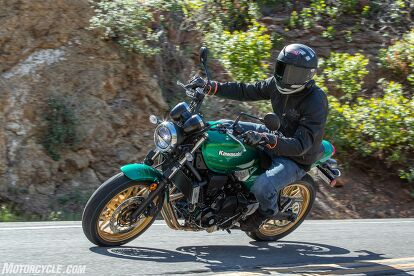
Helmet: Shoei RF-1400 Scanner
- Communicator: Sena Spider ST1 Mesh Intercom Headset
- Jacket: Alpinestars Oscar Bomber
- Airbag: Alpinestars Tech-Air 5
- Pants: Alpinestars Diesel Shiro
- Gloves: Alpinestars SP-2 v2
2022 Kawasaki Z650RS Specifications | |
|---|---|
| Engine Type | Liquid-cooled, 4-stroke Parallel Twin |
| Displacement | 649cc |
| Bore and Stroke | 83.0 x 60.0 mm |
| Compression ratio | 10.8:1 |
| Valve system | DOHC |
| Fuel system | DFI with 36mm Keihin throttle bodies |
| Ignition | TCBI with electronic advance |
| Starting | Electric |
| Lubrication | Forced lubrication, semi-dry sump |
| Horsepower | 61.4 hp at 8100 rpm (measured from Z650) |
| Maximum torque | 43.5 lb-ft. at 6900 rpm (measured from Z650) |
| Transmission | 6-speed, return shift |
| Final drive | Chain |
| Clutch | Wet multi-disc, manual |
| Frame | Trellis, high-tensile steel |
| Front suspension | φ41 mm telescopic fork |
| Front wheel travel | 4.9 in. |
| Rear suspension | Horizontal Back-link with adjustable preload |
| Rear wheel travel | 5.1 in. |
| Front tire | 120/70 ZR17 |
| Rear tire | 160/60 ZR17 |
| Front brakes | Dual semi-floating φ300mm petal discs with dual-piston caliper, ABS |
| Rear brakes | Single φ220 mm petal disc with single-piston caliper, ABS |
| Caster (rake) | 24.0º |
| Trail | 3.9 in. |
| Steering angle (left/right) | 35º / 35º |
| Overall length | 81.3 inches |
| Overall width | 31.5 inches |
| Overall height | 43.9 inches |
| Wheelbase | 55.3 inches |
| Ground clearance | 4.9 inches |
| Seat height | 31.5 inches |
| Curb weight | 412.3 pounds (claimed) |
| Fuel capacity | 3.2 gallons |
We are committed to finding, researching, and recommending the best products. We earn commissions from purchases you make using the retail links in our product reviews. Learn more about how this works.
Become a Motorcycle.com insider. Get the latest motorcycle news first by subscribing to our newsletter here.

Troy's been riding motorcycles and writing about them since 2006, getting his start at Rider Magazine. From there, he moved to Sport Rider Magazine before finally landing at Motorcycle.com in 2011. A lifelong gearhead who didn't fully immerse himself in motorcycles until his teenage years, Troy's interests have always been in technology, performance, and going fast. Naturally, racing was the perfect avenue to combine all three. Troy has been racing nearly as long as he's been riding and has competed at the AMA national level. He's also won multiple club races throughout the country, culminating in a Utah Sport Bike Association championship in 2011. He has been invited as a guest instructor for the Yamaha Champions Riding School, and when he's not out riding, he's either wrenching on bikes or watching MotoGP.
More by Troy Siahaan









































































































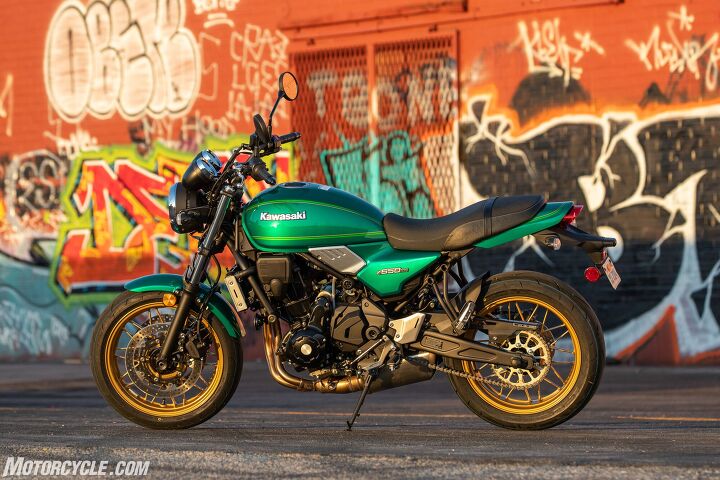

























































































































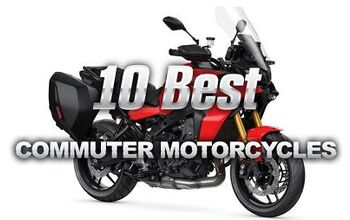



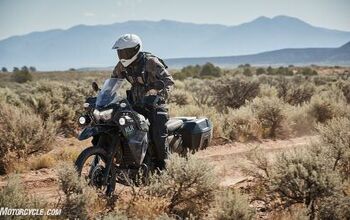

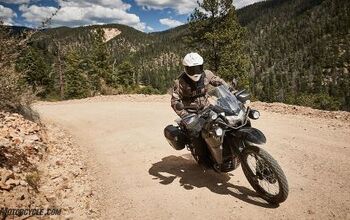


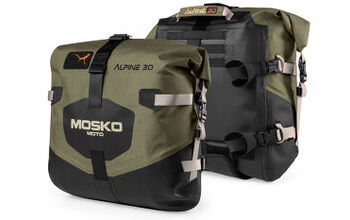








Comments
Join the conversation
Re "For as much as I like the flat, horizontal tail, shouldn’t it be metal instead of plastic?", well, I had a '77 or '78 KZ650, and the tail was plastic. So that's authentic.
Look at the peg location on the '77 bike. Perfect. Why do they all come with pegs located so much higher and back? I look at the pictures of the guy sitting on the newer bike and think I will never own a motorcycle with pegs that require that much knee bend.